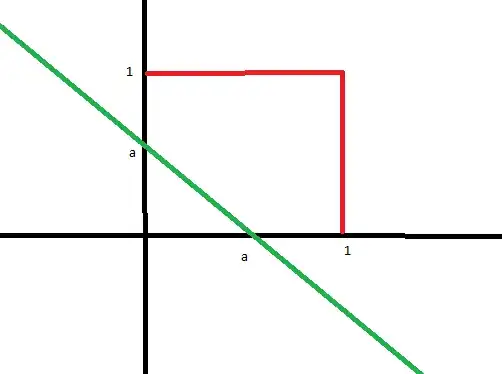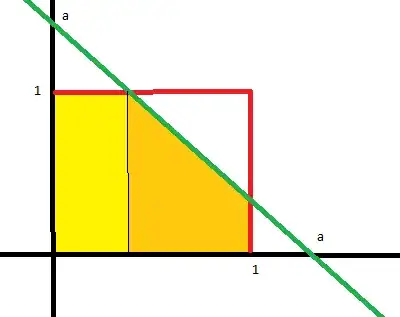I know this very question has been discussed many times on SE here, here, here, here, and here, however after spending time looking over all of those posts, I am still struggling very much with understanding the basic concept, and am wondering if I am missing some fundamental introduction that is causing my lack of understanding. Here is the question:
Let $X$ and $Y$ be two independent random variables uniformly distributed on $[0, 1]$. Compute the probability density function of $X + Y$
The basic setup is
$$f_X(a) = f_Y (a) = \begin{cases} 1, & 0\le a\le1 \\ 0, & \text{otherwise} \end{cases}$$
I would like to to first try go about doing it without using convolution, as André Nicholas recommends here. So I make a sketch:
Where the green line represents $x+y=a$
Now at this point I am confused where to put the green line. Does it make a difference if it is before $1$ or after $1$? If I put it after the $1$ would I have to calculate two different regions like this:
whereas if it is before the $1$ I only have to calculate one region? If so, how do I account for both possibilities?
Also, what do all the answers in those posts mean when they say you have to split up $a$ into two possibilities, one where $0\le a \le 1$ and one where $1\le a \le2$? Can somebody please explain to me in detail why that is necessary, what it actually means, if it can be illustrated in the diagram, and how exactly it expresses itself when setting up the integrals?
Also confusing is when I try to set up a double integral, I do not know how to do it correctly, possibly owing to my lack of understanding regarding the diagram. At first I thought I should do this:
$$P(X+Y \le a) = \int_0^1 \int_{0}^{a-y} \, dx \, dy $$
$$\int_0^1 (a-y)\,dy $$
$$a-{1\over2}$$
Which is incorrect. Somebody else also tried that here, and I don't understand the answer given there as to why these bounds are incorrect, or how to establish the correct bounds.
When I try
$$P(X+Y \le a) = \int_0^a \int_0^{a-y} \, dx \, dy$$
$$\int_0^a(a-y) \, dy $$
I get
$$a^2-{a^2\over2}$$
Which is also incorrect.
Do I need something along the lines of $$ = \int_0^{\min(1,a)}\int_0^{a-y} \, dx \, dy$$
If so, how do I go about doing that? I am not familiar with how to work with $\min, \max$ form in the bounds.
In summary, I am troubled by many things about this problem, and I am wondering if I am missing something very essential, which when I know it will provide with the key to understanding this and similar problems, and if somebody can identify what that is. Thank you very much.

